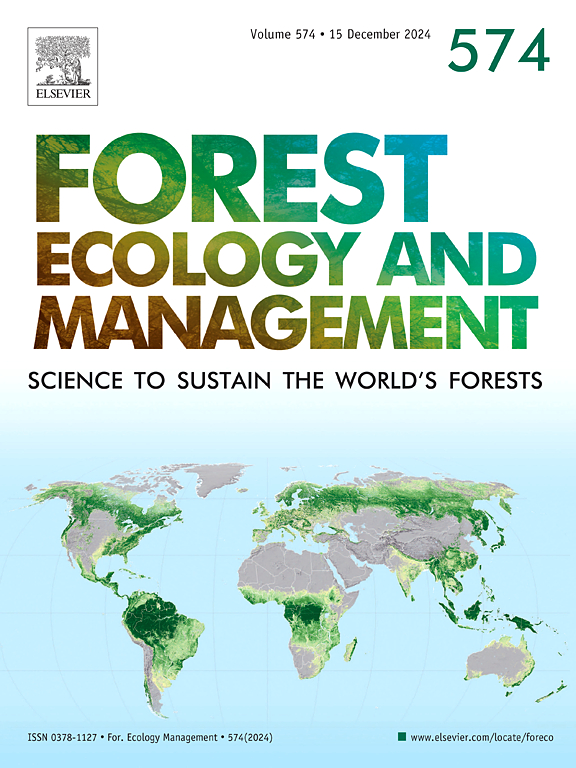山梨对非生物胁迫的生态生理响应:基于综合研究框架的系统综述和文献计量学分析
IF 3.7
2区 农林科学
Q1 FORESTRY
引用次数: 0
摘要
Nothofagus alessandrii是智利特有树种,由于人类活动压力的不断加剧,该树种正面临灭绝的威胁。人工林的快速扩张和栖息地的破碎化大大减少了其分布,破坏了自然再生,损害了种群的生存能力。虽然有几项研究探讨了它对不同气候情景的反应,但结果并不确定。在此背景下,本文旨在综合不同非生物环境胁迫条件下,包括辐射、水分和养分有效性,以及野火引起的干扰,对亚历山德兰的生态生理反应的证据。结果表明,亚历山德里草在生长早期对非生物胁迫条件,特别是干旱条件和高太阳辐射高度敏感。要实现亚历山德里草的有效恢复和恢复,需要控制微环境条件,包括适度遮阳(18 - 50% %树冠覆盖度)、持续的土壤湿度水平、50% %以上的环境湿度和平衡的养分有效性。火灾事件和长期干旱成为自然再生的主要威胁,加剧了小气候压力,降低了幼苗存活率,并促进了外来物种的入侵。这些研究结果强调,迫切需要一个适应性和综合管理框架,同时解决防火、小气候缓冲和土壤保持策略,以确保亚历山德兰种群的长期持久性。本文章由计算机程序翻译,如有差异,请以英文原文为准。
Ecophysiological responses of Nothofagus alessandrii to abiotic stressors: A systematic review and bibliometric analysis toward an integrated research framework
Nothofagus alessandrii, an endemic tree species of Chile, is under threat of extinction due to escalating anthropogenic pressures. Rapid plantations expansion and habitat fragmentation have drastically reduced its distribution, impaired natural regeneration, and compromised population viability. Although several studies have addressed its response to different climatic scenarios, the results have been uncertain. In this context, this review aims to synthesize the evidence of different abiotic environmental stress conditions on the ecophysiological response of N. alessandrii, including radiation, water and nutrient availability, and disturbances caused by wildfires. The results show that N. alessandrii is highly sensitive to abiotic stressors, particularly to drought conditions, and exposure to high solar radiation during early growth stages. Achieving effective restoration and recuperation of N. alessandrii requires controlled microenvironmental conditions, including moderate shading (18–50 % canopy cover), sustained soil moisture levels, ambient humidity above 50 %, and balanced nutrient availability. Fire events and prolonged droughts emerge as the primary threats to natural regeneration, exacerbating microclimatic stress, reducing seedling survival, and facilitating the invasion of exotic species. These findings highlight the critical need for an adaptive and integrated management framework that simultaneously addresses fire prevention, microclimatic buffering, and soil conservation strategies to ensure the long-term persistence of N. alessandrii populations.
求助全文
通过发布文献求助,成功后即可免费获取论文全文。
去求助
来源期刊

Forest Ecology and Management
农林科学-林学
CiteScore
7.50
自引率
10.80%
发文量
665
审稿时长
39 days
期刊介绍:
Forest Ecology and Management publishes scientific articles linking forest ecology with forest management, focusing on the application of biological, ecological and social knowledge to the management and conservation of plantations and natural forests. The scope of the journal includes all forest ecosystems of the world.
A peer-review process ensures the quality and international interest of the manuscripts accepted for publication. The journal encourages communication between scientists in disparate fields who share a common interest in ecology and forest management, bridging the gap between research workers and forest managers.
We encourage submission of papers that will have the strongest interest and value to the Journal''s international readership. Some key features of papers with strong interest include:
1. Clear connections between the ecology and management of forests;
2. Novel ideas or approaches to important challenges in forest ecology and management;
3. Studies that address a population of interest beyond the scale of single research sites, Three key points in the design of forest experiments, Forest Ecology and Management 255 (2008) 2022-2023);
4. Review Articles on timely, important topics. Authors are welcome to contact one of the editors to discuss the suitability of a potential review manuscript.
The Journal encourages proposals for special issues examining important areas of forest ecology and management. Potential guest editors should contact any of the Editors to begin discussions about topics, potential papers, and other details.
 求助内容:
求助内容: 应助结果提醒方式:
应助结果提醒方式:


